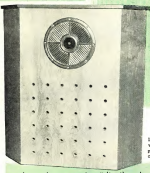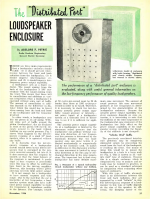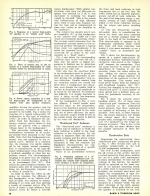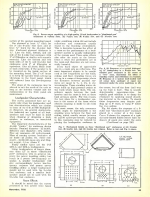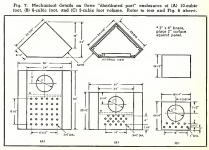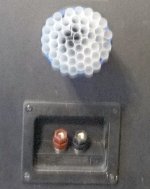Hello Folks,
I have an old and deteriorated bass reflex speaker with 8 inch driver tuned in 50hz and want to make a new enclosure
instead of make an exact copy the box i want to try some experiments
i want to try to make the same box with same tunning but instead of use a single port i want to use multiple ports like the project i saw in this old article
my question-
whats the benefits and disvantages of the distributed port enclosure compared to a single port bass reflex and why they arent so popular
I have an old and deteriorated bass reflex speaker with 8 inch driver tuned in 50hz and want to make a new enclosure
instead of make an exact copy the box i want to try some experiments
i want to try to make the same box with same tunning but instead of use a single port i want to use multiple ports like the project i saw in this old article
my question-
whats the benefits and disvantages of the distributed port enclosure compared to a single port bass reflex and why they arent so popular
Attachments
Distributed port = reduced efficiency for the same total vent CSA through higher frictional etc. losses. This may cause some alignment damping, which typical lumped system modellers do not automatically account for, although you can manually adjust the vent Qp value in some.
Right, a lot of drivers back then had a high Qt, so needed a ~ aperiodic vent to damp them, especially when they had a high Vas also that dictated an otherwise huge box [the one pictured was considered small back then when 'small bookshelf' meant at least 4 ft^3!
Gilbert Briggs of Wharfedale used he term in some of his cabinet designs. He apparently quite liked the ensuing sound. My enclosures for W15 RS speakers (about 7 cu ft) have distributed ports consisting of multiple slots on the back and the overall effect is OK. The bass response goes down to at least 30Hz.
Indeed! Me too! First I saw a ~aperiodic vent was on W.E.'s 555 horn driver where the 'sealed' end was stuffed with S.S. wool and just slots on numerous early pro/cinema sound cabs with 1936 the earliest I've seen. Same horn system, just later catalog: http://www.lansingheritage.org/images/altec/catalogs/1942/page09.jpg
Of course there's all those once ubiquitous mono, stereo consoles' pegboard rear covers. 😉
Of course there's all those once ubiquitous mono, stereo consoles' pegboard rear covers. 😉
lets see if i understood...
im thinking here: is right to say that with distributed port i will have less eficiency because friction and losses, etc... but i will have more cone control than a single port since i understand that it reduces de Qts?
im thinking here: is right to say that with distributed port i will have less eficiency because friction and losses, etc... but i will have more cone control than a single port since i understand that it reduces de Qts?
A Distributed Port (DP) enclosure is more akin to a sealed enclosure than a reflex enclosure, and reduces the amplitude of the Q of its single bass resonance hump.
The low frequency cut-off of a well designed DP enclosure is not as low as a reflex enclosure, but is better than a sealed box of the same volume, while its transient behaviour is said to be appreciably better than both, especially the reflex.
You say you want to experiment, so here's an empirical formula for calculating the DP, or resistive vent, area:
A = 5.5 x V [0.818 (Fs/25) + 0.182]
Where A is the DP area in sq in, V is the enclosure volume in cu ft and Fs is the resonant frequency of the driver in free air.
The low frequency cut-off of a well designed DP enclosure is not as low as a reflex enclosure, but is better than a sealed box of the same volume, while its transient behaviour is said to be appreciably better than both, especially the reflex.
You say you want to experiment, so here's an empirical formula for calculating the DP, or resistive vent, area:
A = 5.5 x V [0.818 (Fs/25) + 0.182]
Where A is the DP area in sq in, V is the enclosure volume in cu ft and Fs is the resonant frequency of the driver in free air.
Quoting from the Wharfedale cabinet construction leaflet:Gilbert Briggs of Wharfedale used he term in some of his cabinet designs.
"The distributed port is the main design novelty in the leaflet and takes the form of a slotted back. The main advantages are that enclosure tuning is not necessary and any type of cone surround can be used. The ventilated back reduces resonance and improves the reproduction of speech, and the cabinet can be placed within an inch of the wall without upsetting the performance. The actual number of slots is not critical, but reducing them raises the frequency and the Q of the main cone resonance. The slots can be replaced by rows of holes which are easily drilled in plywood. The distributed port has been used with success in our W4 and Airedale speakers and also in line source models."
The leaflet shows a design for a 3 cubic foot cabinet, the back of which has ten slots, 12" x 0.25", placed 2" apart. Each slot can be replaced by fifteen holes of 0.5" diameter. The design was especially recommended for the Super 12/RS/DD and RS/12/DD full range speakers.
The series of narrow slots or small holes in the rear of the enclosure are covered internally by a thin, felt like cloth to form a resistive vent.
This may cause some alignment damping, which typical lumped system modellers do not automatically account for
When i do my miniOnken sims i have to keep this in mind. A quite specific sim shape seems to work best when one adds the addiitonal ventR to the box.

dave
...with distributed port i will have less eficiency because friction and losses, etc... but i will have more cone control than a single port
The first i would say is pretty true, and the sound of the bass can be very controlled and nuanced.
It also, tends to make the box more tolerent of dynamic changes in the T/S.
dave
A Distributed Port (DP) enclosure is more akin to a sealed enclosure than a reflex enclosure, and reduces the amplitude of the Q of its single bass resonance hump.
Depends on the detail of how it is done. The same many holes with damping over them all is a common aperiodic technique.
The low frequency cut-off of a well designed DP enclosure is not as low as a reflex enclosure, but is better than a sealed box of the same volume, while its transient behaviour is said to be appreciably better than both, especially the reflex.
Sort of in-between, how much R depends on where in the spectrum of boxes it occurs. Vents with infinite damping are sealed, zero damping some sort of reflex. Many small holes already supply some damping.
dave
Has anyone ever tried a laminar flow element as a resistive port? A laminar flow element is basically a bunch of thin wall tubes of the same length all stacked into a round or rectangular shape. It's an airflow resistor, presenting a linear pressure drop against flow.
Sort of illustrated by the pic. Except neatly done, with each straw cut to the length of the port. (Unsure what adhesive you'd use or how you'd apply it effectively to keep the straws in place...)
Maybe stacking Coroplast sign boards into a rectangular port shape could be another approach...
Sort of illustrated by the pic. Except neatly done, with each straw cut to the length of the port. (Unsure what adhesive you'd use or how you'd apply it effectively to keep the straws in place...)
Maybe stacking Coroplast sign boards into a rectangular port shape could be another approach...
Attachments
Last edited:
Yes, quite popular many decades ago and still in use by the few of us still around. 😉
I wrap[ped] with tape and forced them in.
I wrap[ped] with tape and forced them in.
Last edited:
These four things are the same thing.less eficiency because friction and losses, etc... but i will have more cone control than a single port since i understand that it reduces de Qts?
It does as much as it does. I was exposed to the technique in the early 70s. Didn’t mision have a speaker with a vent that molded the straws in?
Pushes the box towards aperiodic.
dave
Pushes the box towards aperiodic.
dave
There are some musings on how drinking straws in a port work, and how to do better, here:
How Drinking Straws in a Port Work & How to do Better - Jon Risch - Tweakers' Asylum
How Drinking Straws in a Port Work & How to do Better - Jon Risch - Tweakers' Asylum
Thanks! Had totally forgotten this forum/thread.
Right, though the 'click' test I promote whenever appropriate is easiest, most effective, 'all things considered' IME 😉: Click Test | GM210 | Flickr
Right, though the 'click' test I promote whenever appropriate is easiest, most effective, 'all things considered' IME 😉: Click Test | GM210 | Flickr
- Home
- Loudspeakers
- Full Range
- Whats the advantages of "Distributed Port" enlosure
